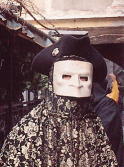back to "The Story of the Mask"
|
back to "The Story of the Mask" |
Venetian Carnivals
 Carnivals were festive events dating back to Roman times. In spite of their
pagan origins, carnivals have also been adopted into the Christian calendar.
Literally speaking this refers to a farewell
to meat festival, which
is followed by the fasting period before Easter, which we now know as Lent.
In addition to eating and drinking, masquerading, all kinds of frivolity and
jokes at the expense of persons unknown, dancing, performances and other programmes
both among the populace and the upper echelons, mocking authority under the
protection of anonymity, etc. were a part of carnivals, even from the beginning
of our chronology.
Carnivals were festive events dating back to Roman times. In spite of their
pagan origins, carnivals have also been adopted into the Christian calendar.
Literally speaking this refers to a farewell
to meat festival, which
is followed by the fasting period before Easter, which we now know as Lent.
In addition to eating and drinking, masquerading, all kinds of frivolity and
jokes at the expense of persons unknown, dancing, performances and other programmes
both among the populace and the upper echelons, mocking authority under the
protection of anonymity, etc. were a part of carnivals, even from the beginning
of our chronology.
In Venice, the carnival tradition
was in full flourish way back in the Middle Ages. Festive and dance structures
were set up in St. Mark’s square. Splendid decorated gondola processions were
organised along the Grand Canal. Masquerading and disguises made sexual equality
possible for the duration of the carnival, irrespective of age and social position.
Commedia dell’arte masks became popular, especially that of Pantalone,
In Venice,
laws regulated the wearing of carnival masks and costumes. Wearing a mask was
much more liberal for the nobility than for members of the lower ranks of
society. Masquerading outside the carnival period resulted in a peculiar
decadent moral atmosphere among the nobility, which enabled private matters to
be dealt with in secret, without others knowing. Many well-known l8th century
figures such as Casanova, Mozart, Goethe and countless European monarchs spent
their time or stayed for long periods in Venice and its scintillating mysterious
world. At the end of the century, Napoleon conquered northern Italy and
prohibited the wearing of masks. The centuries old tradition of masks was over.
During the first half of the 2Oth
century the carnival activities were stopped until they were revived in the
1980s. Nowadays, the Venetian carnival is probably very different in character.
Social and religious limitations are now less restrictive, which means people
can also have fun without the need to hide behind a mask. The return of the
mask, however, has restored something fundamental to Venetian life.